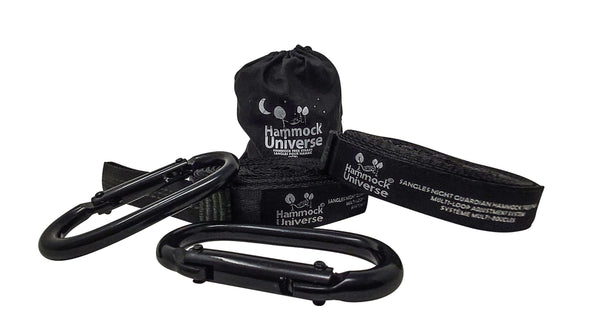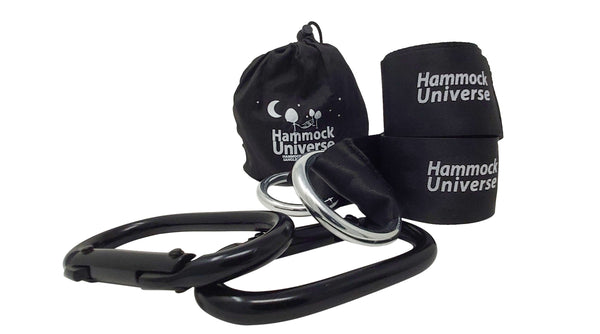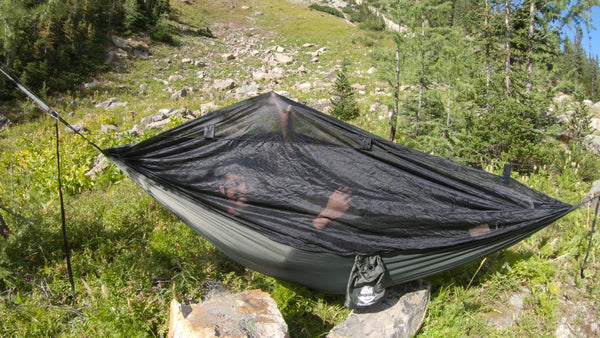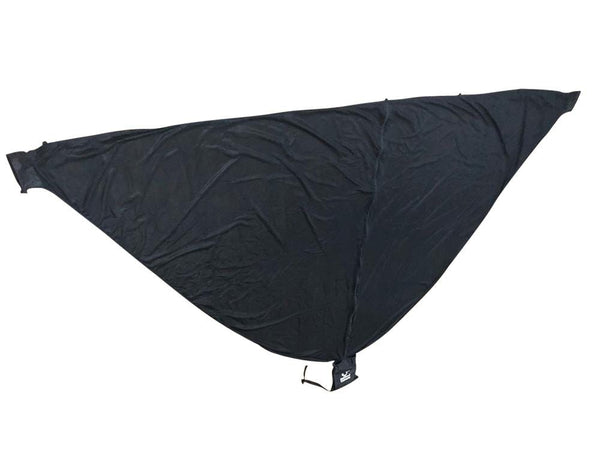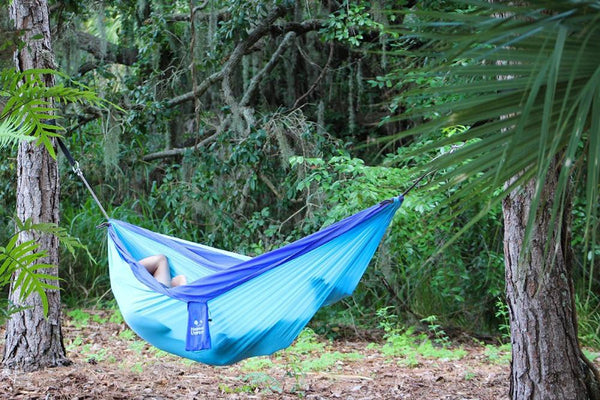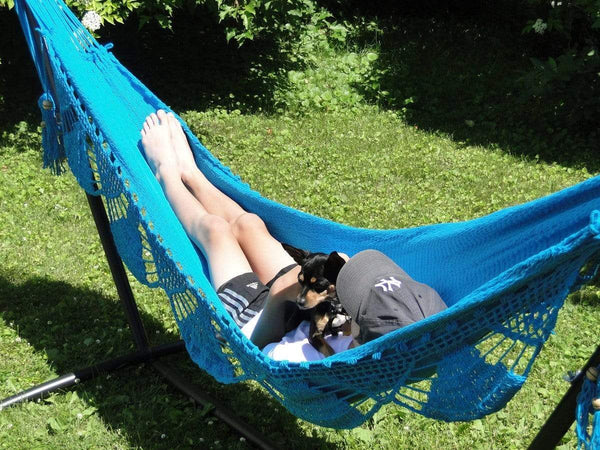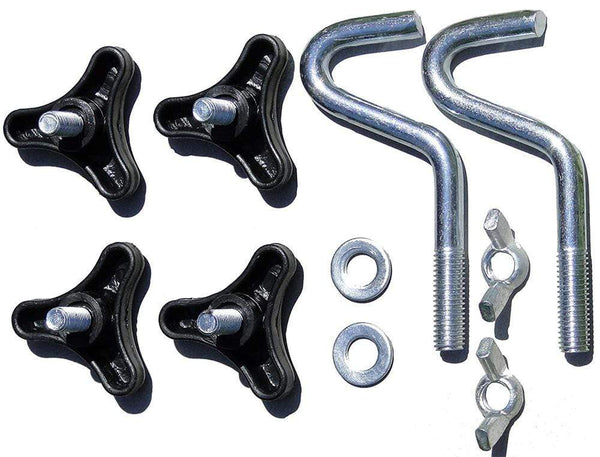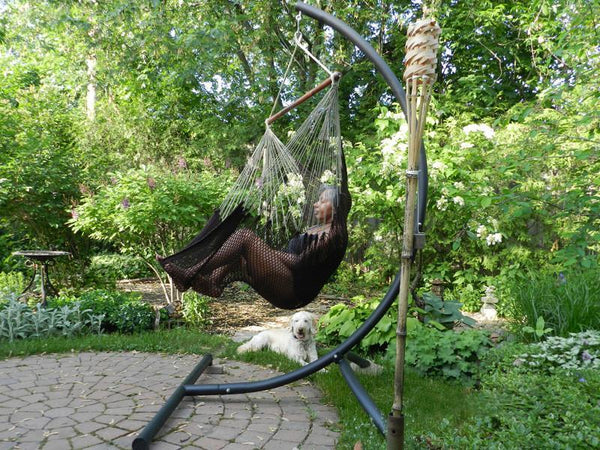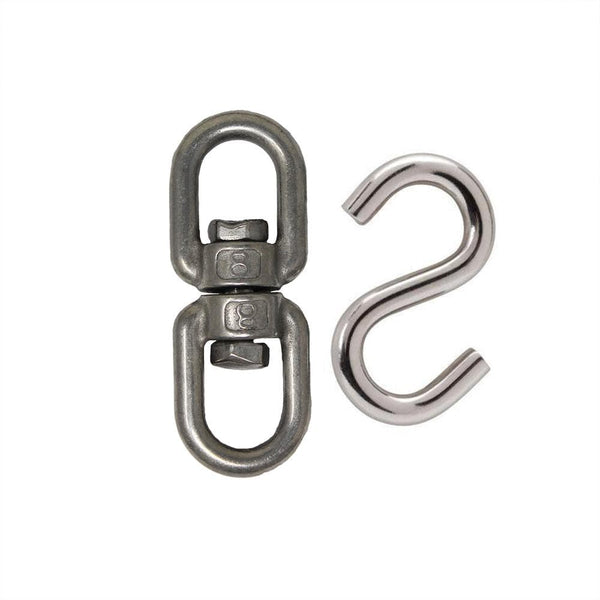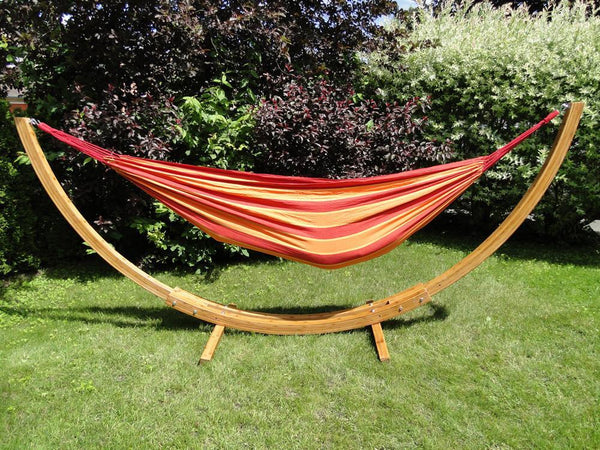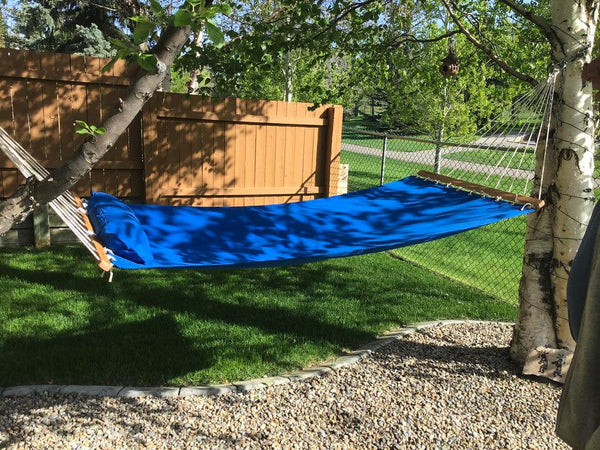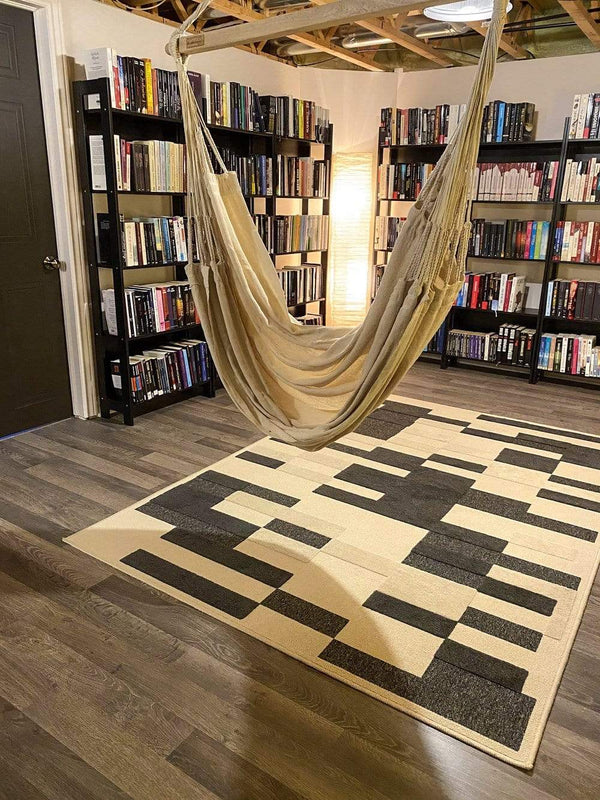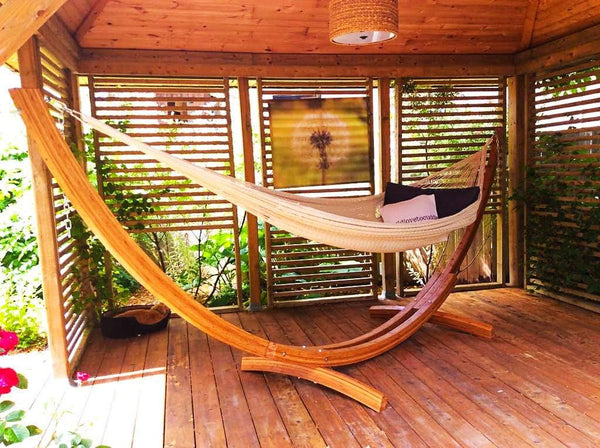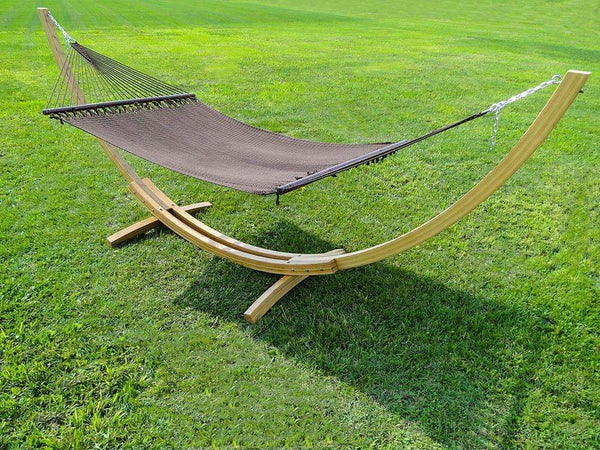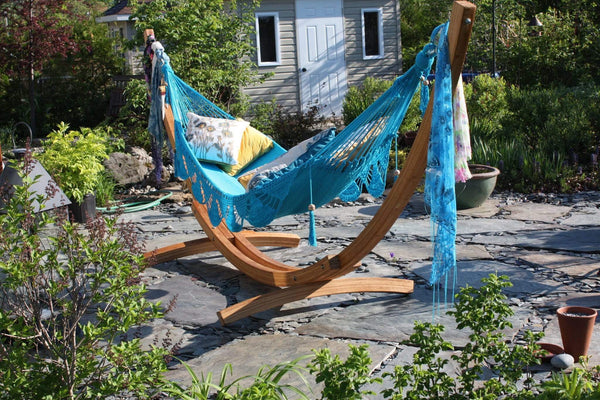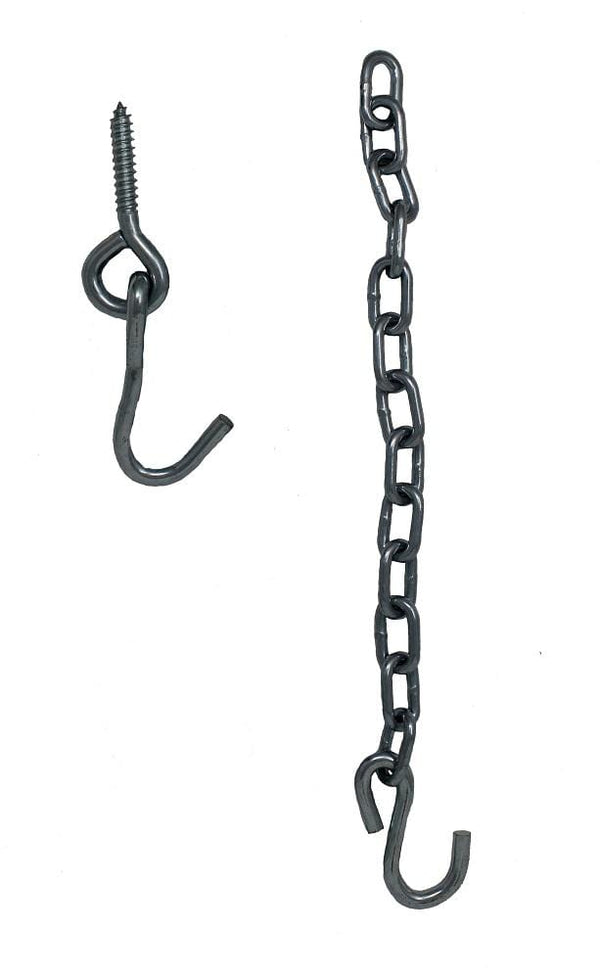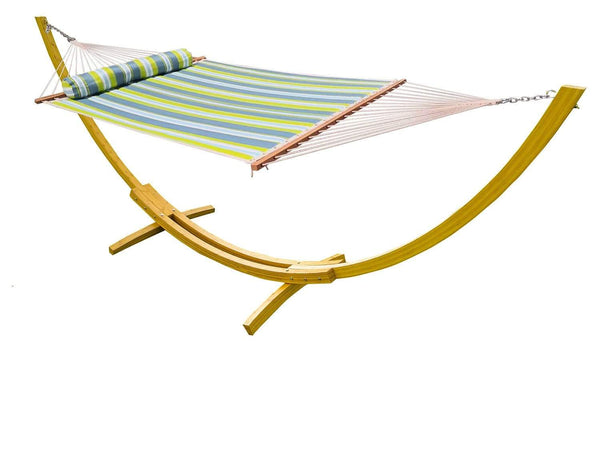FREE SHIPPING on most orders $25+ HAMMOCK BUYING GUIDE
Menu
-
-
Hammocks
-
Hammock Stands
-
Hammocks with Stands
-
Hanging Hammock Chairs
- View all Hammock Chairs
- Brazilian Style Hammock Chairs
- Colombian Hammock Chairs
- Mayan Hammock Chairs
- Mayan Hammock Chairs Deluxe
- Universal Hammock Chair Stand
- U Hammock Chair Stand
- Brazilian Hammock Chair with Universal Chair Stand
- Colombian Hammock Chair with Universal Chair Stand
- Mayan Hammock Chair with Universal Chair Stand
- Mayan Hammock Chair Deluxe with Universal Stand
-
Accessories
- Gift Cards
- Tools and Guides
- Bargain Bin
-
- 1-800-207-4761
- Login

FREE SHIPPING on most orders $25+ HAMMOCK BUYING GUIDE
Must-Have Camping Hammock Accessories
July 16, 2018 7 min read
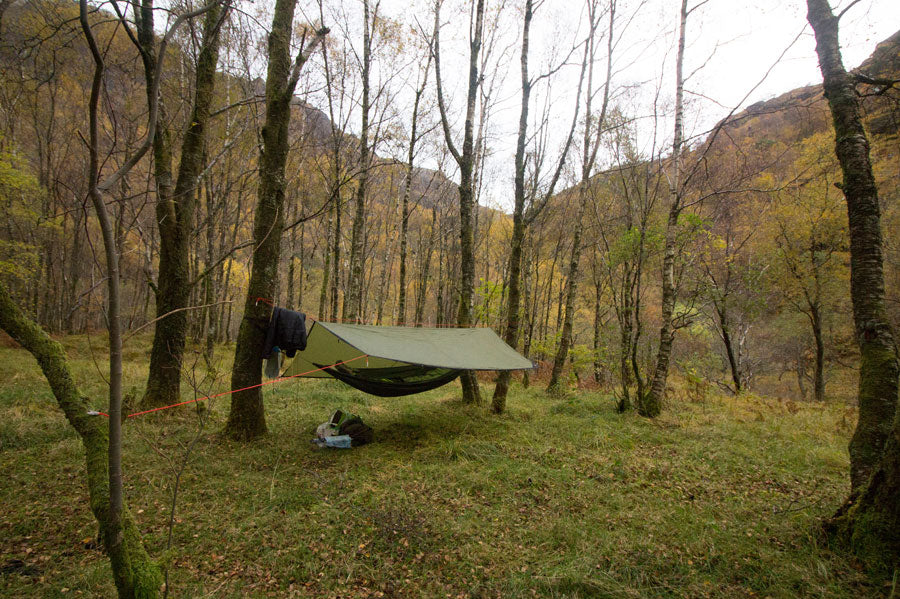
Make the Most Out of Weekend Getaways and Camping Trips With These Accessories
Let’s be honest: the worst part about camping has to be uneven ground beneath your back when you’re trying to sleep.
To be fair, there’s something uniquely wonderful about sleeping on the ground… assuming you’ve got a nice field to pitch your tent in, and don’t need to worry about water, roots digging into your back, or rough stones ruining an otherwise cozy experience.
Hammock camping is the ideal way to camp! It gets you off the ground, rocks you to sleep, and just generally feels adventurous.
Once you’ve tried it, you won’t want to return to camping on the ground. Plus, you get to save significant packing space! Hammocks are lightweight and easy to pack. They are also much easier to set up than a tent, and they provide the best night’s sleep.
But to ensure you have the optimal camping experience, you need the best accessories for your hammock to keep you warm, comfortable, and sheltered from the bugs and elements.
Tent vs. Hammock Camping: What’s the Difference?
The main differences between tent and hammock camping are the shelter and bed. For tent camping, you need to find an ideal spot to set up a tent, preferably a level, dry ground with no rocks or tree roots. Then you have to take the time to set up your tent.
For hammock camping, you just need two trees that are spaced well enough apart to hang your hammock comfortably. And then you can hang your hammock easily in a few minutes.
You can also add accessories to transform your hammock into a hammock tent that provides the same shelter as a regular tent, but with a much more comfortable place to sleep.
Benefits of Hammock Camping Over Tent Camping
Compared to tents, hammocks are more comfortable, enjoyable, and easier to set up and take down.
Here are some of the many benefits of hammock camping.
Better Sleep
Who doesn’t want to be rocked gently off to sleep?
Hammocks provide a better night’s sleep than sleeping in a tent. Many factors can hurt your sleep (and back) in a tent. You might be sleeping on a rock, tree root, slope, or wet ground.
But when hammock camping, you’ll never have to worry about the condition of the ground again.
When a hammock is set up properly, you will have the most comfortable and restful sleep you’ve ever experienced while camping.
Fresh Air
Sleeping in a hammock provides more fresh air and ventilation than a tent will, even if the tent’s windows are open. You’ll fall asleep and wake up breathing in fresh air.
This makes mornings even better since you won’t have to worry about baking in your tent once the sun is up. Instead of rushing out of your tent in a half-asleep groggy and sweaty haze, you can wake up relaxed and comfortable, taking in the sights and sounds of nature.
Same Protection
With the wide variety of hammock accessories available, you can go hammock camping with the same shelter, protection, and privacy that tents offer, but with the added benefits of sleeping in a hammock.
And depending on the season, you can layer up or leave a layer behind, so you’ll always be comfortable no matter the weather or bugs.
Convenience
Hammocks are much easier to carry and set up than tents. They are lightweight, portable, and unlike tents, they are more than just a place to sleep.
You can use your hammock as a chair while hanging out at the campsite. Or, use it as a comfortable place to lounge and read a book.
The Right and Wrong Types of Hammocks for Camping Outdoors
While acceptable for hanging in your backyard, rope hammocks with spreader bars are not ideal for camping. They are clunky and difficult to pack and carry. And they are uncomfortable for sleeping in all night.
The spreader bars disturb the natural center of gravity in a hammock, so you’ll be at more risk of flipping over in the night. It also makes for a less even weight distribution that can cause back pain.
So when going hammock camping, make sure you use a lightweight, durable, quick-drying hammock without spreader bars that is easy to pack, such as a nylon parachute hammock.
Must-Have Items
Mosquito Net Hammock Duo
Mosquitos are every camper’s nightmare. And if you’re planning to sleep outdoors on a hammock, you’ll become a feast for mosquitos without the right protection.
A great two-in-one option is to bring along a mosquito net hammock. Not only is it an excellent tent replacement but it's a lightweight, compact, and durable option for your hammock camping needs. The best part? This hammock comes with a mosquito net attached so you can sleep soundly and bite-free!
If you already have a solid camping hammock, you should consider getting a mosquito or bug net for your hammock. You’ll thank yourself later when you aren’t covered from head to toe in bug bites.
Look for nets that have superfine netting to keep even the smallest bugs out. And consider using full nets that provide 360-degree bug protection. Full nets will have zippers on the side to get in and out of your hammock easily.
Straps & Suspensions
If you’re going to hang a hammock, you’ll need the hammock hanging gear to do it. For hammock camping, tree straps are the best hanging gear to have.
Simply wrap the straps around two trees that are a good distance apart so your hammock can hang with a bit of slack (suspended at about a 30 degree angle) and at a comfortable sitting height from the ground.
The ideal distance between trees (depending on the length of your hammock) is between 13 and 16 feet. But if you have long enough straps, you can hang your hammock between two trees up to 20 feet apart.
Once the straps are in place, hook the hammock ends to the straps with carabiners or hooks.
If you don’t have tree straps, you can use rope. Just make sure you’re a pro at tying knots so the rope stays secure around the tree.
Repair Kits
Anything can happen to your hammock when you’re out in the wild. Snags, tears, burns, and holes can appear and get worse over time. But with a hammock repair kit on hand, you can easily repair damage to your hammock before it turns into a big problem.
Hammock repair kits should have a peel-and-stick application to quickly repair small rips and holes that are about three inches or less.
Planning for Bad Weather: Keeping Dry and Warm
Although you’ll be hanging outside while you sleep, you can still stay warm and dry in your hammock, even in winter.
Tarps
One of the best things about hammock camping is being able to look up at the stars while you slowly rock to sleep. But the nights won’t always be clear, and you might encounter a storm every now and then.
To shelter yourself from the elements on windy, rainy, or even snowy nights, hang a tarp above your hammock. Most hammock tarps can be turned into a tent-like shelter.
Tarps vary in shape, size, thickness, and weight. The type you choose will depend on how much coverage you want and how much extra weight you’re willing to carry.
But do make sure the tarp covers along the ridgeline and width of the hammock, and extends to about six to 12 inches past each end of your hammock.
For summer, smaller diamond tarps will do. But for spring and fall, consider catenary hexagonal tarps.
Large, full-coverage, four-season tarps are ideal for extra shelter from the cold, wind, and snow while winter camping. These allow you more privacy with rainflys and doors for added shelter. These resemble a pitched tent that provides full protection for your hammock.
To set up tarps for hammocks, you’ll need guy lines and rope or cord for a ridgeline to suspend the tarp over. Drape the tarp over the ridgeline to create a tent shape.
Quilts
Hammock quilts are at the top of the list for winter hammock camping gear you need. Hammock quilts provide that extra layer of insulation to help you stay warm at night when the temperature dips.
Since you’ll be suspended above ground and exposed to the open air, the air flowing above and below you will make you chilly at night. This uncomfortable cold feeling is commonly referred to as “cold butt syndrome.”
Hammock quilts are made of an insulating material, either down or synthetic, to keep you warm and prevent "cold butt syndrome" even in winter.
Under quilts hang underneath hammocks, keeping your back side protected from the cold. And top quilts provide another layer of insulation to keep you warm on top.
When choosing hammock quilts, look for those that resemble the shape of your body when you are lying down in your hammock.
Make sure they are rated to keep you warm at the temperature you’ll be camping in. For example, if you plan to camp in winter, the quilts should provide enough insulation to withstand sub-zero temperatures going into the -20s at least.
Sleeping Pads
For additional insulation and protection from the cold, and for added comfort, there are sleeping pads available designed to fit in hammocks. Instead of having sharp corners like traditional sleeping pads, hammock sleeping pads have tapered ends to easily slide into hammocks.
Hammock sleeping pads are usually inflatable or filled with down or synthetic insulation. There are also closed-cell foam pads available.
Some campers use sleeping pads and sleeping bags for insulation in warmer weather. And then add quilts when camping in the colder months.
Pillows
Pillows also help keep your head insulated and comfortable for a better night’s sleep in a hammock. Some sleeping pads come with pillows attached already.
But if you’re shopping for a hammock pillow, look for one that works well in both hot and cold temperatures—i.e. a pillow made with both fleece and microfiber materials.
Pillows are also easy to stuff in a bag and lightweight to carry. So the bit of extra space they take up is worth it for the extra comfort you’ll have while sleeping.
No matter the weather, with the right hammock gear, you can enjoy your camping trips to the fullest any time of year.
Safety First!
When using a hammock*, safety is paramount. Please make sure to follow these important guidelines when purchasing, installing and using a hammock
*(includes Hammock, Hammock Chair, Hammock Stand and Hammock Accessories)
Safety First!
When using a hammock*, safety is paramount. Please make sure to follow these important guidelines when purchasing, installing and using a hammock
*(includes Hammock, Hammock Chair, Hammock Stand and Hammock Accessories)
Related Products
Want to relax?
Join for exclusive content and promotions we only give to our email list!

